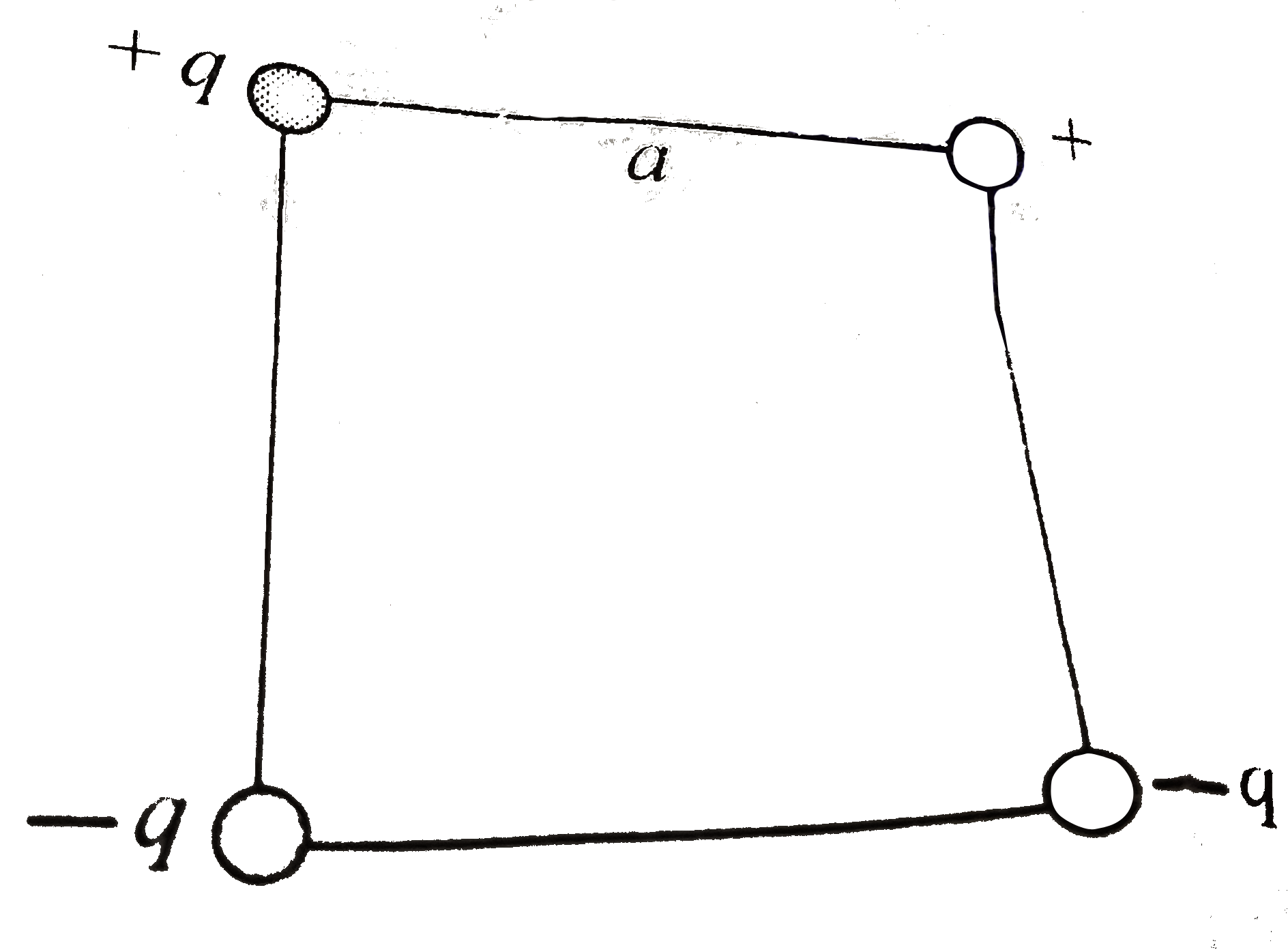The particles shown in Fig. 24-69 each have charge magnitude q = 5.00 pC and were initially infinitely far apart. To form the square with edge length a=64.0 cm, (a) how much work must be done by an external agent, (b) how work must be done by the electric forces, and (c) what is the potential energy of the system?

(a) −0.908pJ, (b) 0.908bJ, ( c)−0.908pJ
Topper's Solved these Questions
- ELECTRIC POTENTIALBOOK - RESNICK AND HALLIDAYCHAPTER - ELECTRIC POTENTIALEXERCISE - (PRACTICE QUESTIONS) Single Correct Choice Type
21 Videos
- ELECTRIC POTENTIALBOOK - RESNICK AND HALLIDAYCHAPTER - ELECTRIC POTENTIALEXERCISE - (PRACTICE QUESTIONS) More than One Correct Choice Type
8 Videos
- ELECTRIC POTENTIALBOOK - RESNICK AND HALLIDAYCHAPTER - ELECTRIC POTENTIALEXERCISE - CHECKPOINT
6 Videos
- ELECTRIC CHARGES AND FIELDSBOOK - RESNICK AND HALLIDAYCHAPTER - ELECTRIC CHARGES AND FIELDSEXERCISE - Practice Questions (Integer Type )
3 Videos
- ELECTROMAGNETIC INDUCTIONBOOK - RESNICK AND HALLIDAYCHAPTER - ELECTROMAGNETIC INDUCTIONEXERCISE - PRACTICE QUESTIONS (Integer Type)
14 Videos
Similar Questions
A factory worker pushes a 25.0 kg crate downward at an angle of 30∘ below the horizontal a distance of 6.0 m along a level floor.
(a) What magnitude of force must the worker apply to move the crate at constant velocity, if the coefficient of kinetic friction between the crate and floor is 0.3 ?
(b) How much work is done on the crate by this force when the crate is pushed a distance of 6.0 m?
(c) How much work is done on the crate by friction during this displacement ?
(d) How much work is done by the normal force and by gracity ?
(e) What is the total work done on the crate ? Take g=10m/s2
View SolutionHow much work must be done to increase the speed of an electron from rest to (a) 0.500c, (b) 0.990c, and (c )0.99990c?
View SolutionTwo points charges are located on the x-axis, q1=−1μC at x=0andq2=+1μc at x=1m.
a. Find the work that must be done by an external force to bring a third point charge q3=+1μC from infinity to x=2m.
b. Find the total potential energy of the system of three charges.
View SolutionTwo points charges are located on the x-axis, q1=−1μC at x=0andq2=+1μc at x=1m.
a. Find the work that must be done by an external force to bring a third point charge q3=+1μC from infinity to x=2m.
b. Find the total potential energy of the system of three charges.
View SolutionTwo points charges are located on the x-axis, q1=−1μC at x=0andq2=+1μc at x=1m.
a. Find the work that must be done by an external force to bring a third point charge q3=+1μC from infinity to x=2m.
b. Find the total potential energy of the system of three charges.
View SolutionIn the previous problem, suppose that another force in addition to the electrical force acts on the particle so that when it is released from rest, it moves to the right. After it has moved 5 cm, the addition force has done 9×10−5J of work and the particle has 4.5×10−5J of kinetic energy.
(a) What work was done by the electrical force ?
(b) What is the magnitude of the electric field ?
(c) What is the potential of the starting point with respect to the end point ?
View SolutionWhat minimum work must be done by an external force to bring a charge q=3.00μC from a great distance away (take t=∞) to a point 0.500m from a charge =20.0μC ?
View SolutionWhat minimum work must be done by an external force to bring a charge q=3.00μC from a great distance away (take t=∞) to a point 0.500m from a charge =20.0μC ?
View SolutionTwo charges q1=3.0μC and q2=−4.0μC initiallly are separated by a distance r0=2.0cm. An external agent moves the charges until they are rf=5.0cm apart.
(i) How much work is done by the electric field in moving the charges from r0 to rf ? Is the work positive or negative ?
(ii) How much work is donw by the external aganet in moving the charges from r0 to rf ? Is the work positive or negative ?
(iii) What is the positive energy of the initial state where the charge are r0=2.0 cm apart ?
(iv) What is the potential energy of the final state where the charges are rf=5.0cm apart ?
(v) What is the change in potential energy from the initial state to the final state ?
View SolutionFour charges are placed at four corners of a square as shown in figure. The side of the square is a. Two charges are positive and two are negative, but their magnitudes are the same. Now, an external agent starts decreasing all the sides of the square slowly and at the same rate. What happens to the electrical potential energy of the system and what will be the nature of work done by the agent?

View Solution
